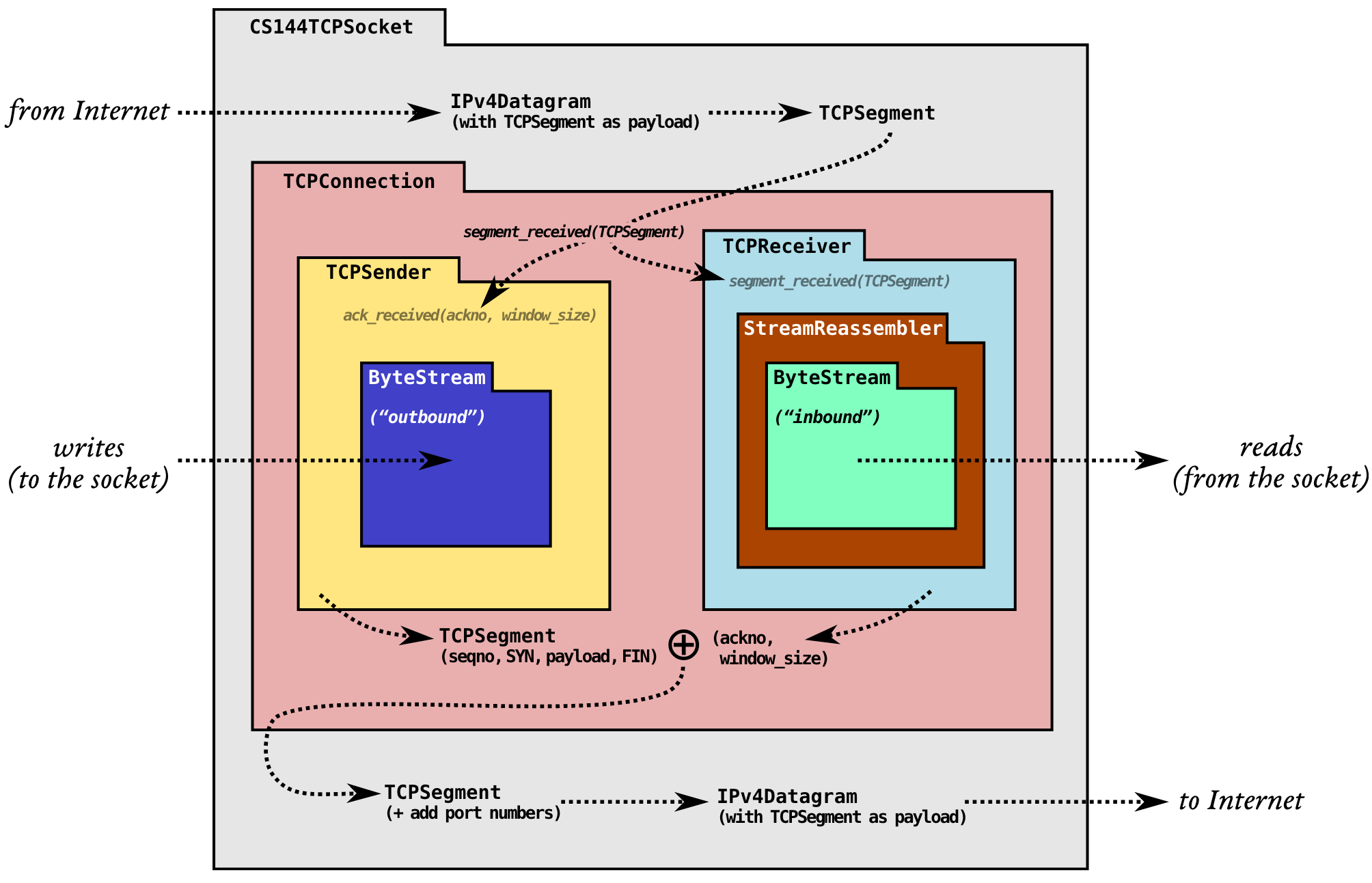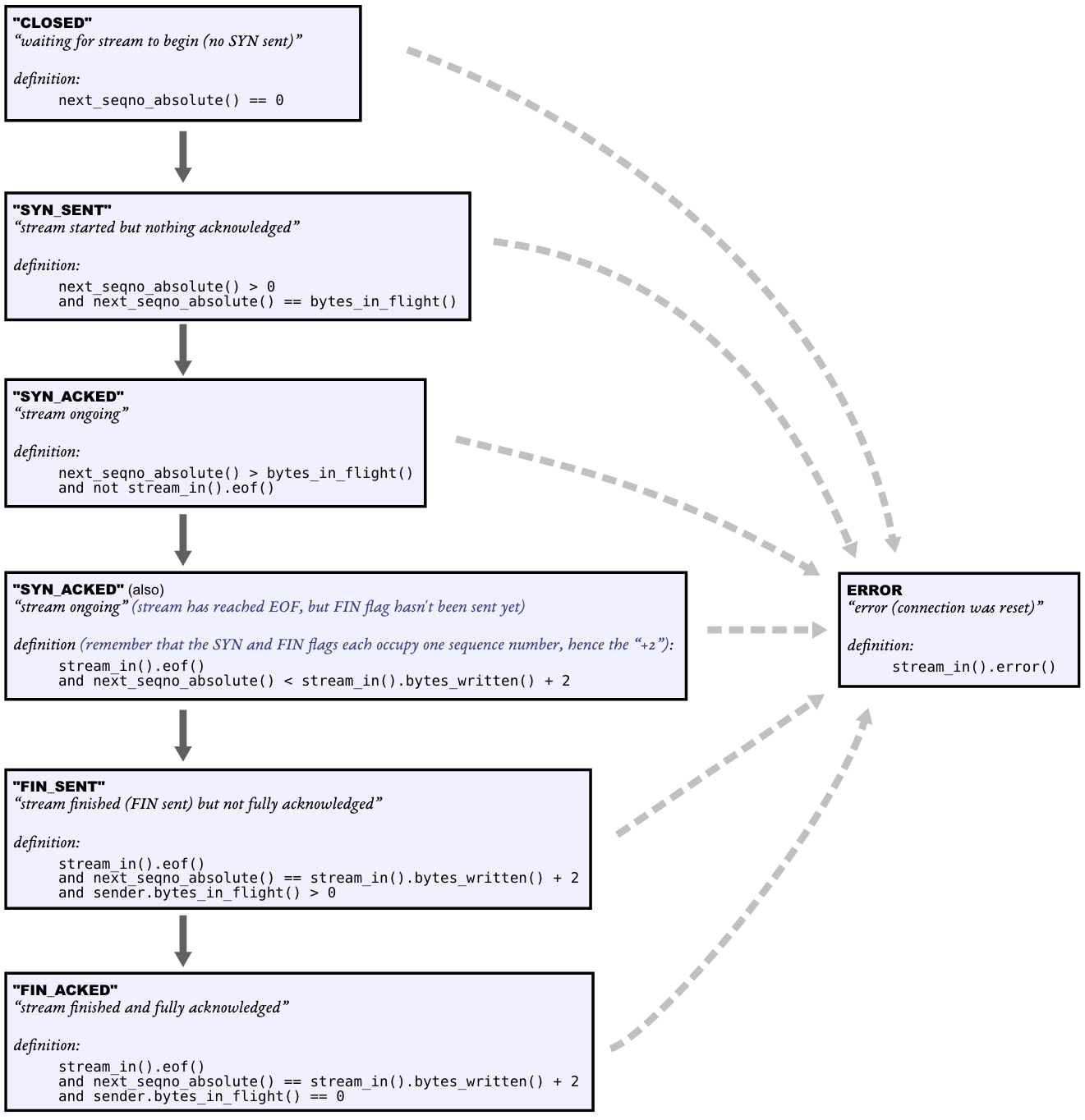本文最后更新于:2024年1月10日 下午

The arrangement of modules and dataflow in TCP implementation.
在Lab3中,需要实现一个TCPSender,主要有以下几个功能:
- 根据接收方的响应调整发送窗口;
- 发送
SYN,FIN报文;
- 从
ByteStream中读取、创建并发送新的TCPSegment;
- 跟踪已发送的
Segment,直到被确认接收,必要时进行超时重传。
A. How does the TCPSender know if a segment was lost?
在Lab0中介绍过,TCP是在不可靠的链路上提供尽力而为的可靠传输。为了实现这一目的,在TCP中,TCPSender需要确保每一个Segment都被成功接收。
每当一个Segment被发送出去,TCPSender会记录其发送的时间并标记为未完成的,当超过retransmission timeout(RTO)毫秒后,如果依然没有确认收到,就会进行重传。
这是由一个全局的计时器来实现的,具体来说,TCPSender的重传遵循以下几个规则:
- 每隔一段时间(毫秒),
TCPSender的Tick()方法会被调用,并带有一个参数ms_since_last_tick代表自上次调用该方法以来已经过去了多少毫秒。
- 当
TCPSender被构造时,会附带一个_initial_retransmission_timeout参数,代表重传时限(retransmission timeout, RTO) 的初始值。RTO是重新发送未完成的TCP Segment前要等待的毫秒数。随着通信进行,RTO可能会发生变化,但是初始值保持不变。
- 每次发送携带数据的
Segment时,如果计时器(Timer)没有运行,就启动它。
- 当所有未完成的
Segment都被确认后,停止Timer。
- 当
Tick()函数被调用,且已经过期时:
- 立即重传最早的未被确认的
Segment。
- 如果
window size非零:(指数退避)
- 记录连续重传次数
consecutive retransmissions,并在发生重传时增加它。
RTO *= RTO。
- 重启
Timer。
- 当接收方向发送方发出了新的确认时:
- 重置
RTO为初始值。
- 如果
Sender中还有未被确认的Segment,就重置Timer,并使其在RTO毫秒后过期。
- 归零重传计数器。
Time代码如下:
tcp_sender.hh&tcp_sender.cc1
2
3
4
5
6
7
8
9
10
11
12
13
14
15
16
17
18
19
20
21
22
23
24
25
26
27
28
29
30
31
32
33
34
35
36
37
38
39
40
41
42
43
44
45
46
47
48
49
50
51
|
class Timer {
private:
bool _is_running{false};
unsigned int _consecutive_retransmissions_times{0};
unsigned int _retransmission_timeout{0};
unsigned int _time_passed{0};
public:
Timer();
void Timer::start(const unsigned int _initial_retransmission_timeout) {
_is_running = true;
_consecutive_retransmissions_times = 0;
_retransmission_timeout = _initial_retransmission_timeout;
_time_passed = 0;
}
void Timer::stop() { _is_running = false; }
void Timer::reset(const unsigned int _initial_retransmission_timeout) {
stop();
start(_initial_retransmission_timeout);
}
void Timer::restart() { _time_passed = 0; }
void Timer::time_update(const unsigned int ms_since_last_tick) {
if (_is_running)
_time_passed += ms_since_last_tick;
}
void Timer::exponential_backoff() {
_consecutive_retransmissions_times++;
_retransmission_timeout *= 2;
}
bool Timer::check_expired(const unsigned int ms_since_last_tick) {
if (_is_running) {
time_update(ms_since_last_tick);
}
if (_time_passed >= _retransmission_timeout) {
return true;
}
return false;
}
bool Timer::is_running() const { return _is_running; }
|
B. Implementing the TCP sender
Evolution of the TCP sender
现在我们可以来实现一下TCPSender了。首先我们需要了解一下Sender的各种状态:

Evolution of the TCP sender (as tested by the test suite).
在CS144中,各个状态能干的事情,其中在CLOSED和SYN_ACKED状态时,在发送SYN和FIN信号的同时也是可以携带数据的(不过我觉得现实中应该是不可以的)。除此之外,在SYN_SENT状态发完SYN还是可以继续发只有数据的Segment,分的不是很清楚。
| 状态 |
发送信号 |
发送数据 |
重传数据 |
| CLOSED |
1 |
0 |
0 |
| SYN_SENT |
0 |
1 |
1 |
| SYN_ACKED |
1 |
1 |
1 |
| FIN_SENT |
0 |
0 |
1 |
| FIN_ACKED |
0 |
0 |
0 |
| ERROR |
0 |
0 |
0 |
Functions of the TCP sender
成员变量
我添加了以下几个成员变量,其中_segments_cache用来储存还未确认收到的Segment,_ackno用来记录确认收到的最大的seqno。
1
2
3
4
5
| Timer _timer{};
unsigned int _window_size{0};
std::queue<TCPSegment> _segments_cache{};
uint64_t _ackno{0};
enum _status { CLOSED, SYN_SENT, SYN_ACKED, FIN_SENT, FIN_ACKED, ERROR } _status{CLOSED};
|
bytes_in_flight()
返回未被确认的Segment数量,直接用下一个未发送seqno减去最后一个被确认的seqno即可。
1
2
3
| uint64_t TCPSender::bytes_in_flight() const {
return _next_seqno - _ackno;
}
|
fill_window()
先计算一下这一次调用最多能发送多少数据fill_size:用window size减去目前未确认的Segment。需要注意的是当状态为CLOSE的时候,window size是0,这个时候可以发送syn,我们可以把window size当作1。
那么显然,当状态是CLOSE或者fill_size > 0且fin未发送时,我们就可以主动发送Segment了。
当状态时CLOSE时,我们就可以开启一个TCP链接了,发送一个syn信号,并将seqno设置为_isn,状态更新成SYN SENT。
当状态是SYN SENT(CS144中SYN Segment也可能携带数据)或SYN ACKED且有需要发送的数据(发送正常的纯数据Segment)或数据流终止(关闭TCP,发送fin)时:
- 先计算能填装的数据量,
fill_size和MAX_PAYLOAD_SIZE取最小。
- 填装数据。
- 如果装完之后发现数据流终止了,我们就可以设置
fin信号了。(注意fin也会占用一个seqno,所以需要先确认这次发送是否能装下,否则就要等下一轮了)
- 将
Segment发送出去,并更新_next_seqno。
如果在发送Segment时Timer没有运行的话,就启动Timer。
如果当前轮已发送的是一个不含数据的Segment,即指包含了信号的话,就可以直接结束这次发送了。如果含有数据,我们还需要更新一下fill_size,继续发送。
1
2
3
4
5
6
7
8
9
10
11
12
13
14
15
16
17
18
19
20
21
22
23
24
25
26
27
28
29
30
| void TCPSender::fill_window() {
size_t fill_size = (_window_size ? _window_size : 1) - bytes_in_flight();
while (_status == CLOSED || (fill_size && _status != FIN_SENT)) {
TCPSegment segment;
if (_status == CLOSED) {
segment.header().syn = true;
segment.header().seqno = _isn;
_status = SYN_SENT;
}
if (_status == SYN_SENT or (_status == SYN_ACKED && (!_stream.buffer_empty() or _stream.eof()))) {
size_t payload_len =
min(fill_size, TCPConfig::MAX_PAYLOAD_SIZE);
segment.header().seqno = wrap(_next_seqno, _isn);
segment.payload() = _stream.read(payload_len);
if (_stream.eof() && fill_size-segment.length_in_sequence_space()) {
segment.header().fin = true;
_status = FIN_SENT;
}
_segments_out.push(segment);
_segments_cache.push(segment);
_next_seqno += segment.length_in_sequence_space();
}
if (!_timer.is_running()) {
_timer.start(_initial_retransmission_timeout);
}
if (!segment.length_in_sequence_space())
return;
fill_size -= segment.length_in_sequence_space();
}
}
|
ack_received()
先将收到的ackno转换成absoult seqno,并确保其在我们可接受地范围内(在未确认的seqno之中)。
如果当前状态是SYN SENT则更新成SYN ACKED,并清除缓存_segments_cache中对应的Segment,并重置Timer。需要注意的是,对于含有fin信号的Segment,我们需要单独处理,在这个环节就将它排除了。
若此时状态是FIN SENT且已经确认到了fin信号(注意syn和fin都会占一个seqno,且seqno是从0开始的),则更新成FIN ACKED,并清除缓存。
最后,如果缓存是空的,则停止Timer。
1
2
3
4
5
6
7
8
9
10
11
12
13
14
15
16
17
18
19
20
21
22
23
24
25
26
| void TCPSender::ack_received(const WrappingInt32 ackno, const uint16_t window_size) {
uint64_t absoult_ackno = unwrap(ackno, _isn, _ackno);
if (absoult_ackno < _ackno || absoult_ackno > _next_seqno) {
return;
}
_ackno = absoult_ackno;
_window_size = window_size;
if (_status == SYN_SENT)
_status = SYN_ACKED;
while (!_segments_cache.empty() &&
unwrap(_segments_cache.front().header().seqno, _isn, _ackno) < unwrap(ackno, _isn, _ackno) && !_segments_cache.front().header().fin) {
_segments_cache.pop();
_timer.reset(_initial_retransmission_timeout);
}
if (_status == FIN_SENT && _ackno == _next_seqno) {
_status = FIN_ACKED;
_segments_cache.pop();
}
if (_segments_cache.empty())
_timer.stop();
}
|
tick()
当Sender处于SYN SENT、SYN ACKED或是FIN SENT状态时,调用Timer检查当前是否过期。
如果已过期,则:
- 若
window size非0或SYN未确认收到时,执行指数退避。
- 若重传次数小于
TCP内建的限制次数时,立即重传并重启Timer。
1
2
3
4
5
6
7
8
9
10
11
12
13
| void TCPSender::tick(const size_t ms_since_last_tick) {
if (_status == SYN_SENT or _status == SYN_ACKED or _status == FIN_SENT)
if (_timer.check_expired(ms_since_last_tick)) {
if (_window_size || _status == SYN_SENT)
_timer.exponential_backoff();
if (consecutive_retransmissions() <= TCPConfig::MAX_RETX_ATTEMPTS) {
_segments_out.push(_segments_cache.front());
_timer.restart();
} else {
_status = ERROR;
}
}
}
|
consecutive_retransmissions()
返回Timer中记录的重传次数。
1
2
3
| unsigned int TCPSender::consecutive_retransmissions() const {
return _timer.consecutive_retransmissions_times();
}
|
本文链接: https://zone.ivanz.cc/p/785ad61c.html

